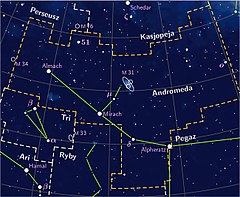Mayall II
 Mayall II (HST) | |
| Dane obserwacyjne (J2000) | |
| Gwiazdozbiór | Andromeda |
|---|---|
| Rektascensja | 00h 32m 46,51s |
| Deklinacja | +39° 34′ 39,7″ |
| Odległość | 2,9 mln ly (890 kpc) |
| Jasność obserwowana | 13,7 m |
| Charakterystyka fizyczna | |
| Masa | 15 mln M☉ |
| Alternatywne oznaczenia | |
| Globular One, MII, G1, NGC-224-G1, SKHB 1, GSC 2788:2139, HBK 0-1 lub Gromada Andromedy | |
 Konstelacja Andromedy | |
Mayall II (Globular One, MII, G1, NGC-224-G1, SKHB 1, GSC 2788:2139, HBK 0-1 lub Gromada Andromedy) – gromada kulista w galaktyce Andromedy w gwiazdozbiorze Andromedy.
Mayall II znajduje się w odległości około 2,9 mln ly od Ziemi i ok. 170 tys. lat świetlnych od centrum galaktyki M31. Masa jest prawdopodobnie dwukrotnie większa niż gromady Omega Centauri – wynosi ok. 15 milionów mas Słońca, co stawia ją na pierwszym miejscu spośród znanych gromad kulistych. Szacuje się, że gromada może zawierać od kilkuset tysięcy do miliona gwiazd.
Mayall II jest jedną z 97 potwierdzonych gromad kulistych należących do M31[1]. Istnieją jednak przypuszczenia, że jest ona tak naprawdę jądrem galaktyki karłowatej, która utraciła zewnętrzne warstwy na skutek oddziaływania grawitacyjnego z M31[2].
Przypisy
- ↑ Klasyfikacja gromad kulistych M31 (ang.)
- ↑ G. Meylan i inni, Mayall II = G1 in M31: Giant Globular Cluster or Core of a Dwarf Elliptical Galaxy?, „The Astronomical Journal”, 2, 122, s. 830-841, DOI: 10.1086/321166, Bibcode: 2001AJ....122..830M (ang.).
Linki zewnętrzne
- Mayall II w SEDS.org (ang.)
- Mayall II w bazie SIMBAD (ang.)
- Jarosław Włodarczyk. Gromada kulista Andromedy. „Wiedza i Życie”. 9, 1996. Prószyński Media sp. z o.o..
Media użyte na tej stronie
Autor: Oryginalnym przesyłającym był Blueshade z polskiej Wikipedii, Licencja: CC-BY-SA-3.0
Ta mapa gwiazdozbioru została stworzona przy pomocy programu PP3 autorstwa Torstena Brongera. Tłumaczenia na język polski oraz innych modyfikacji na potrzeby polskiej Wikipedii dokonał Przemysław 'BlueShade' Idzkiewicz. Grafika udostępniona jest na licencji GFDL w wersji 1.2 lub nowszej.
Autor: Judy Schmidt from USA, Licencja: CC BY 2.0
An intensely interesting globular cluster due to its unusual metallicity and possible home to an intermediate mass black hole, Mayall II or G1 is part of the Andromeda galaxy. It has been proposed and widely accepted that this cluster may very well be the remnant nucleus of a dwarf galaxy which had its outer layers pulled away and incorporated into the Andromeda galaxy. The cluster currently resides in Andromeda's outer reaches, which gives us a very good vantage point to see it without a lot of unrelated stars mingling in around it.
This is some of the finest data I've ever had the pleasure to work with, with many exposures combined to create a very smooth noise floor and incredible signal to noise ratio. Virtually everything you see is either a star or a background galaxy, with cosmic rays and instrumental artifacts almost completely removed. If you zoom in on the cluster, you can see even some very faint members of the cluster resolved. Exquisite.
Filters used include near-infrared and near-ultraviolet, resulting in very colorful stellar populations. Aside from the obvious brightest stars, many of the small, very red sources are actually foreground stars which may easily be mistaken as part of the cluster. I only know this because around 8 years elapsed between some of the exposures, revealing proper motions of several stars. I ended up compensating for this by nudging them into place for the composition. I also had to deal with some misaligned diffraction spikes, which involved carefully picking them up and rotating them to match with the others. You may still be able to see some misalignment if you look closely.
Data from the following two proposals were used to create this image: The Hot Stellar Content and HB morphology of the massive globular cluster G1 Resolving Multiple Stellar Populations in G1
North is 37.00° counter-clockwise from up.
Red: WFC3/UVIS F814W Orange: WFC3/UVIS F606W Cyan: WFC3/UVIS F438W
Blue: WFC3/UVIS F336W
